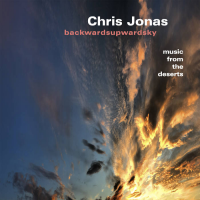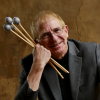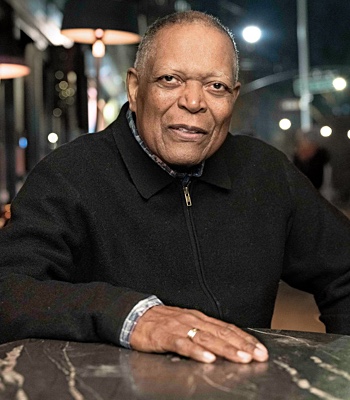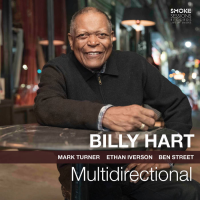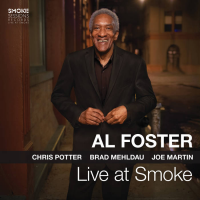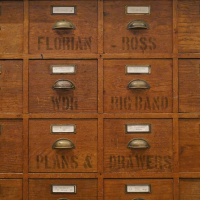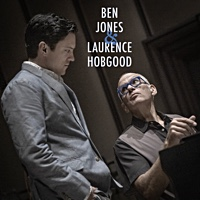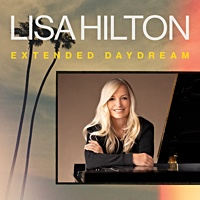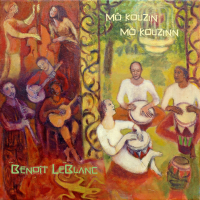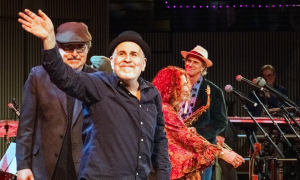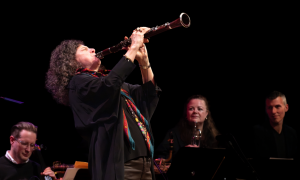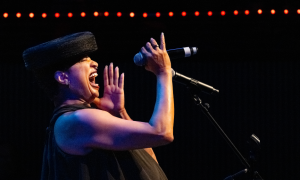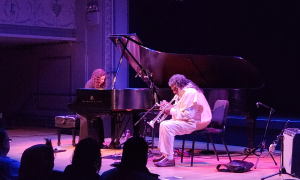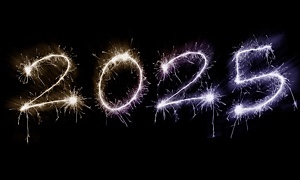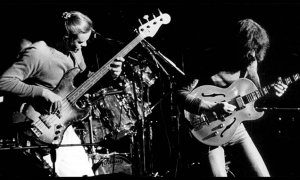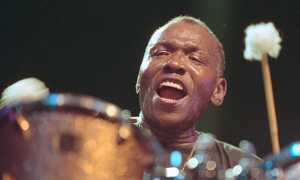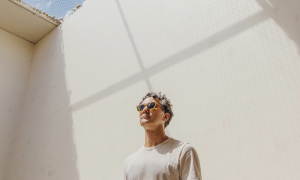Home » Jazz Articles » Live Review » Paul McCartney at Coors Field
Paul McCartney at Coors Field
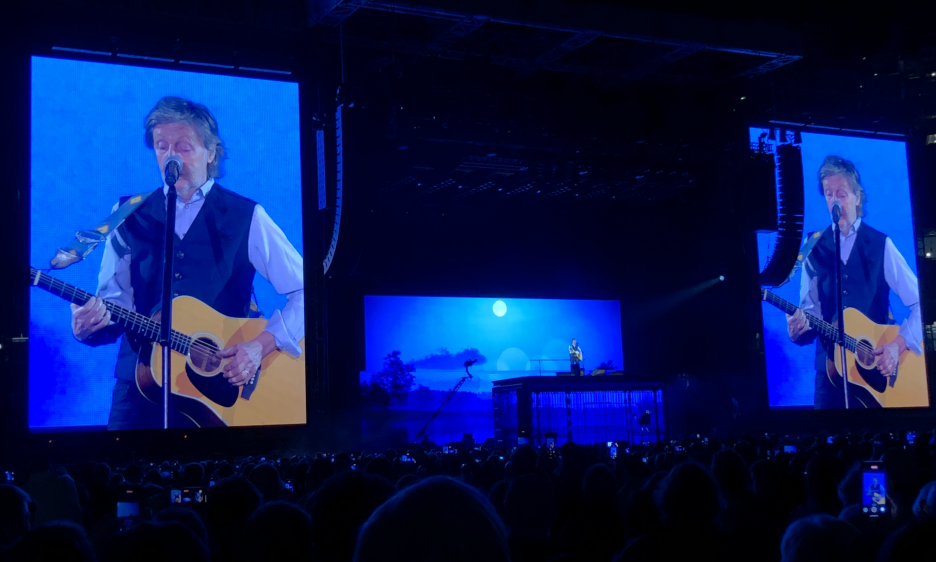
Courtesy Geoff Anderson
Coors Field
Denver, CO
October 11, 2025
A Paul McCartney concert, unlike most other musical events, is laden with cultural significance, bearing carts of baggage both good and bad; but mostly good. The weight of context complicates attempts at a dispassionate evaluation of the music. But it is music. It is inextricably intertwined with passion and emotion. Because of his longevity and cultural impact, McCartney's music just carries more of that weight than average. And all that is why 50,000 people turned out to see the former Beatle at Denver's outdoor baseball stadium on a mid-October evening as part of his continuing "Got Back" tour.
Over the course of 36 songs, McCartney and his long-time band brought back memories from over 60 years ago. However, a sizable percentage of the audience had not been around that long. Still, chances are, their memories of McCartney and the Beatles stretch to their earliest years and, like McCartney's baby boomer contemporaries, span almost their entire lives.
Such is the impact of McCartney and the Beatles. Parents play this music for their kids, and when those kids have children of their own, the cycle repeats. While the baby boom generation was well represented, so were all age groups. Many full family units were in attendance. The pre-concert email from the venue warned: "Attendees of all ages require a ticket for entry, including children under the age of three." Usually, it is not necessary to say that for a rock concert.
McCartney is now 83 years old and the years have started to affect his vocals. He has retained most of his falsetto and the ability to hit many of those high "oooos," but he could not consistently nail every note. Some were a little scratchy and some seemed non-existent. Those were the exception, however, and most of the time, Paul sounded like Paul, even if there were a few waivers here and there. His four main bandmates (excluding the horns) all sang spot-on harmonies. And so did the audience on nearly every song (although the harmonies were not quite as accurate), helping to fill in any missing notes or low-volume output from the main man.
But these are minor quibbles. It was Sir Paul! The audience was there to relive days gone by. Even if many of those days were only a few weeks ago. And McCartney delivered on that score. Most of his and the Beatles' songs are fairly short, and the instrumental jams Saturday night were limited, allowing the inclusion of many Beatles and Wings favorites as well as a few from McCartney's solo career. Despite squeezing three dozen songs into the program, the missing hits were interesting. Left behind were such McCartney classics as "Yesterday," "Eleanor Rigby," "And I Love Her," The Fool On The Hill," "Can't Buy Me Love," "Good Day Sunshine," "I Saw Her Standing There," "The Long and Winding Road," "Michelle," "Paperback Writer," "Penny Lane," "She Loves You," "She's a Woman," "Uncle Albert/Admiral Halsey," "When I'm Sixty-Four," "Your Mother Should Know," "Why Don't We Do It In The Road" (well, maybe not that one) and more. Obviously, there was insufficient time for everything, but this shows how deep and wide McCartney's hit songs are. Few other songwriters can match this record.
The evening started with "Help," a song most often attributed to John Lennon. But, except for covers and songs written by George Harrison, all the Beatles' songs list "Lennon/McCartney" as the composers. So why not play this one? Before this tour, McCartney had never played "Help" in concert. It is always good to freshen up the set list.
Generally, McCartney sprinkled his lesser-known songs among the hits in the first half of the concert. "Coming Up," the second tune of the evening, was a hit in 1980, but certainly not to the degree of many Beatles and even Wings songs. It is, however, bouncy and energetic and served to keep the energy going after the iconic "Help" and its classic 12-string guitar chord to launch it. "Letting Go," a Wings tune, was originally on Venus and Mars (Capitol, 1975). It only reached around #40 on various charts when it was released as a single. But Saturday night, it was a vehicle for the band to stretch out a bit and feature the three-piece Hot City Horns comprising Kenji Fenton on sax, Mike Davis on trumpet and Paul Burton on trombone.
"Come On To Me" followed "Letting Go" and was one of the few compositions from this century. The song appeared on McCartney's album Egypt Station (Capitol, 2018). It is a pick-up song (no, not an F-100, it is about being on the prowl at a bar or a party) and its rocking attitude picked things up after "Letting Go," which is a bit brooding, but in a good way. Another 21st-century song was "My Valentine," written for McCartney's current wife, Nancy. It appeared on Kisses on the Bottom (Capitol, 2012). McCartney wrote this one when he was still courting Nancy and they were on a trip to Morocco, where it rained the entire time. Stuck in the hotel, McCartney took advantage of the piano in the lobby and worked out the song to present to his new friend. Apparently, it worked. He and Nancy have been married for 14 years. By this time in the show, McCartney had moved to the grand piano where he could give the song the gentle and sentimental treatment it deserved.
Another 21st-century song that may not have been familiar to those who drifted away from McCartney after the Beatles or even Wings was "Dance Tonight." This one appeared on Memory Almost Full (MPL Communications, 2007). McCartney pulled out a mandolin for this one, which would be at home at a foot-stomping hoe down. In contrast to the occasional appearance of 21st-century works was a version of the first recorded effort of the future Beatles in 1958, "In Spite of All the Danger." When Lennon and McCartney first met in Liverpool in the late 1950s, Lennon had a band named the Quarry Men, named after Lennon's school, Quarry Bank High School. McCartney joined the band and shortly afterward, the mates scraped together five quid to pay a small recording studio to record two songs. One of the songs was Buddy Holly's "That'll Be The Day," but the other is the only song with composer credits to McCartney/Harrison. McCartney acknowledges that Lennon had a hand in composing "In Spite of All the Danger," but the boys did not know much about songwriting credits at that time.
The session yielded a single copy of the record, which the band members shared by holding it for a week and playing for their friends and family, then passing it on. The recording ended up, for 23 years, in the hands of Duff Lowe, who was the keyboard player for the Quarry Men at the time. The little disc has been considered the most valuable record in the world. McCartney got it back in 1981. Saturday night, McCartney used the song to play an electric guitar solo on one of his left-handed Gibson Les Paul guitars. Following this performance of the first song recorded by the future Beatles, the band followed with the first professional recording of the Beatles, "Love Me Do" with keyboard player Wix Wickens on harmonica.
"Now and Then" may have been the most interesting song and the most difficult to place on a timeline. This is the song McCartney released in 2023 as the last Beatles song. It was on a cassette that John Lennon recorded in his apartment in 1978. Lennon's widow, Ryoko Ono, gave the cassette to McCartney after Lennon's 1980 death. Also on that cassette were "Free As A Bird" and "Real Love," which the surviving Beatles reworked and released in 1995. "Now and Then" presented several technical issues, in addition to George Harrison's objection that the song was "rubbish," and so it was not released at that time.
Twenty-eight years after that first attempt to clean up and release "Now and Then," technology had advanced sufficiently, and with the help of AI, allowed the sound engineers to extract Lennon's voice and also eliminate an incessant buzz caused by the electrical system in Lennon's apartment. The result is a love song from Lennon to his bandmates and, in the context of Saturday night's concert, a love song from McCartney to the rest of the Beatles. Sample lyrics: "I know it's true, it's all because of you / And if I make it through, it's all because of you."
As part of the 2023 release of "Now and Then," McCartney and Ringo Starr produced a video. AI was used there, too, to reunite McCartney and Starr with Lennon and Harrison as well as with their younger selves. Saturday night, the video played behind the band while they performed it.
Another unusual entry in the set list was an instrumental version of Jimi Hendrix's "Foxey Lady" as a coda to "Let Me Roll It," a Wings tune. This one gave McCartney another opportunity for a guitar solo. After the song, he told a story of how he was hanging out in a small London club in 1967 when some band plugged in their equipment and started playing. It turned out to be the Jimi Hendrix Experience. There were very few people in the club that night, but three nights later, the place was packed because of the word-of-mouth raving about this new band.
Throughout the evening, McCartney played at least eight different instruments. Of course, he started the evening with his most famous axe, the Hofner bass. But he spent more time playing guitar and guitar-like instruments, including two different left-handed Les Paul electric guitars, an acoustic guitar, a mandolin and a ukulele. He also played a grand piano elevated above the stage by several steps and an upright piano that allowed him to get closer to the edge of the stage and face the audience while he sang. The front of the upright also doubled as a screen for projecting the pictures, cartoons and abstract designs throughout the evening.
McCartney has successfully cultivated a "nice guy" image, probably since at least the beginning of his rise to fame. It is also possible that he really is a nice guy. In any event, this has gone a long way toward establishing his family-oriented fan base. He has managed to be a rock 'n' roller, at least sometimes, but he has also managed to appear more or less non-threatening. In contrast, some of his contemporaries, such as Mick Jagger and the Rolling Stones and Robert Plant of Led Zeppelin started out in more of a bad boy role. The more pop-orientation of McCartney's material is also a big factor.
"Helter Skelter," appearing on The White Album (Apple, 1968), has a bit of a star-crossed legacy, especially in the family-friendly context. McCartney set out to create the "loudest, dirtiest" rocker possible after Pete Kubryk Townsend said The Who had just recorded such a song (maybe "I Can See For Miles," which does not strike 21st-century ears as the "loudest and dirtiest" ever). But the term "Helter Skelter" was the name of a British amusement park attraction consisting of a giant cone with a slide curling around the outside. An interior stairway allowed children to climb up, slide down, repeat. That is family-friendly!
But then there is Charles Manson. The California psychopath was convinced the Beatles were speaking to him through The White Album, and "Helter Skelter" was his particular obsession. During the Tate-LaBianca murders, directed by Manson, one of the perpetrators wrote "Healter Skelter" [sic] on a refrigerator door written in the blood of one of the victims. After all that, McCartney was understandably hesitant to play the song in concert. Saturday night, the song found its way into the encore, sandwiched between "Sgt. Pepper's Lonely Hearts Club Band (Reprise)" and "Golden Slumbers."
The obligatory solo set happened a little over halfway through the show. For this sequence, McCartney rode the stage as it elevated. His solitary figure on the elevated stage, flanked by giant images of him, illustrated his larger-than-life persona, but also demonstrated that he is just another man, standard-sized flesh and blood.
His first solo number was "Blackbird." He told the story of writing it during racial violence in the American southeast in the mid to late 1960s. He recalled a Beatles concert in Jacksonville, Florida. As the band waited backstage to start the show, the promoter came to warn the band that the audience had been racially segregated, with Whites on one side and Blacks on the other. The Beatles had never heard of such a thing and did not think it was a good idea. The band considered the situation and then told the promoter they would not play to a segregated audience. After an argument, the promoter relented and allowed the audience to mix. McCartney said he met a Black woman years later who had been at that show. She said she had never sat next to White people at a concert, but it did not matter because everyone was just a Beatles fan. And to help understand the song, it is useful to know that "bird" is common British slang for woman or girl.
In a chatty mood, McCartney frequently engaged with the crowd between songs. At one point, he mentioned the ubiquitous signs near the front of the stage. He remarked about one woman's sign announcing she has attended 186 McCartney concerts. "That's a bit obsessive, don't you think?"
He spoke a lot about Lennon. The follow-up to "Blackbird" was "Here Today," a love song he wrote to Lennon after his death. He lamented that the rough, tough guys like he and Lennon were in the 1950s and '60s would never tell one of their male friends that he loved him. But, in the case of Lennon, he wished he had.
McCartney also paid tribute to George Harrison, the other fallen Beatle. For this one, McCartney played a ukulele and explained that he and Harrison had played Harrison's song, "Something," together, each Beatle on his own ukulele. This version started with McCartney singing and strumming the ukulele on his own, but the full band joined about halfway through for a much bigger production.
As the concert continued into the latter stages, the big hits came out, one after the other: "Ob-La-Di, Ob-La-Da," "Band on the Run," "Get Back" and "Let It Be." Another hit of this stature is "Hey Jude." But putting "Let It Be" and "Hey Jude" back-to-back would not work well because of the similarities between those two songs. Solution? Insert "Live and Let Die" in between. Written for a James Bond movie of the same name, this one required drama, Bond drama.
The outdoor venue of the ballpark allowed McCartney to deliver not just flash pots on stage and flames on the video, but also live fireworks. Certainly, the rockets soaring several hundred feet above the stage is not something that can be accomplished in an indoor arena. "Hey Jude" closed the main set with the na-na-na sing-along.
Lennon appeared again on screen for the first song of the encore, "I've Got A Feeling." The song integrated film of Lennon singing on the Apple studio rooftop, which appeared in the movie Let It Be. After the tune, McCartney remarked that he liked that song because he could sing with John again.
In 2002, McCartney released a DVD entitled ,Back In The U.S.: Concert Film. Unlike Saturday night's show, the 2002 version of McCartney in concert did not include a horn section. However, the other four band members were the same on Saturday night. Rusty Anderson is still the guitarist. In the 2002 film, he told a story of having a dream as a kid that the Beatles came to his house and asked him if he would like to play with them. Not only did that dream more or less come true, but one day McCartney walked into their rehearsal and told him, "I had a dream about you."
Brian Ray alternated between guitar and bass, strapping on the latter whenever McCartney played guitar or keyboards, which was about three-quarters of the time.
Paul "Wix" Wickens played keyboards, accordion and the critical harmonica part on "Love Me Do."
Since the 2002 film, all the band members have "matured," but drummer Abe Laboriel, Jr. changed the most—in a good way. In 2002, he appeared to weigh somewhere close to 300 pounds. It seemed a bit incongruous because his active drumming style clearly burned a marathon's worth of calories during a concert. Last night, Laboriel appeared as a new man, having shed about half of his 2002 girth. His drumming remained just as energetic.
After "I've Got A Feeling," the encore continued with several songs that served as the finale of Abbey Road (Apple, 1969), but in a different order. "Golden Slumbers" was followed by "Carry That Weight," then "You Never Give Me Your Money" and finally and fittingly, "The End."
In all, McCartney had been on stage continuously for about two and a half hours; no small feat for an 83-year-old.
Set List
Help; Coming Up; Got to Get You Into My Life; Drive My Car; Letting Go; Come On To Me; Let Me Roll It; Foxey Lady; Getting Better; Let 'Em In; My Valentine; Nineteen Hundred and Eighty-Five; Maybe I'm Amazed; I've Just Seen A Face; In Spite of All the Danger. Quarry Men song; Love Me Do; Dance Tonight; Blackbird; Here Today; Now and Then; Lady Madonna; Jet; Being For the Benefit of Mr. Kite!; Something; Ob-La-Di, Ob-La-Da; Band on the Run; Get Back; Let It Be; Live and Let Die; Hey Jude; Encore; I've Got a Feeling; Sgt. Pepper's Lonely Hearts Club Band (Reprise); Helter Skelter; Golden Slumbers; Carry That Weight; You Never Give Me Your Money; The End.Tags
PREVIOUS / NEXT
Support All About Jazz
 All About Jazz has been a pillar of jazz since 1995, championing it as an art form and, more importantly, supporting the musicians who make it. Our enduring commitment has made "AAJ" one of the most culturally important websites of its kind, read by hundreds of thousands of fans, musicians and industry figures every month.
All About Jazz has been a pillar of jazz since 1995, championing it as an art form and, more importantly, supporting the musicians who make it. Our enduring commitment has made "AAJ" one of the most culturally important websites of its kind, read by hundreds of thousands of fans, musicians and industry figures every month.




